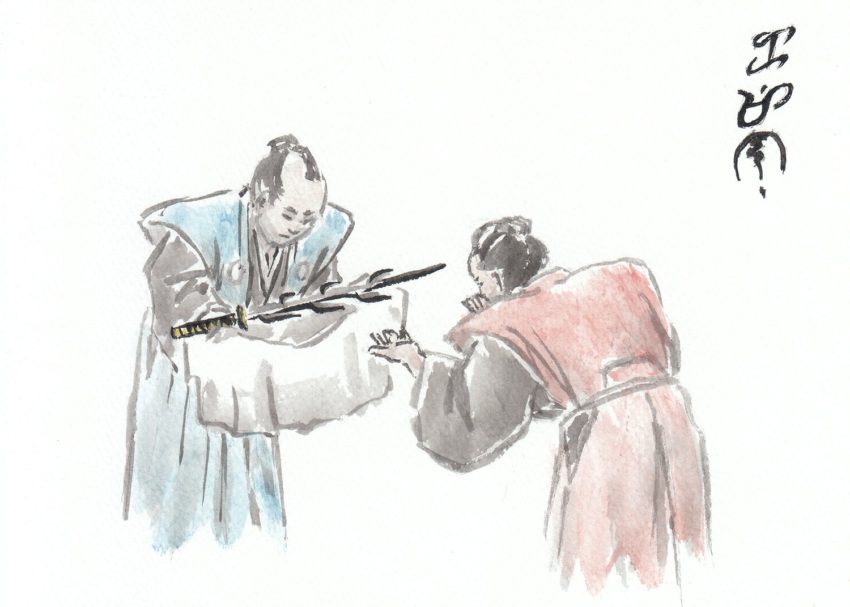Not every sword is made for the express purpose of warfare. Indeed, most sword-making cultures have at least one instance of a sword being presented to serve as a badge of office or for use in some sort of ritual. Russell Crowe’s film Gladiator highlighted the “rudius”, a wooden sword that would be granted to an exceptional gladiator for his service in entertaining the Roman public. It signified that he had been released from slavery. Unsurprisingly, there are a fair number of Japanese ceremonial swords to discuss. In this article we’ll go over nihontoNIHONTO 日本刀 "Japanese sword" learn more... that were primarily intended for military dress, ritualist practices, diplomatic gifts or a particular ceremony rather than any martial pursuit.
Shichishito: The Seven-Branched Sword
This ceremonial Japanese sword’s name literally translates as “seven-branched sword.” It was gifted to the Japanese empress Jingu by Korea’s Baekje Kingdom. It remains stored at a shrine in Nara, Japan, and is not kept viewable to the public.
As if the translation of its name were not a clue to its unwieldiness as a weapon, Shichishito has an overall length of just over 29 inches, with the full length of its central blade spanning nearly 26 inches. The seven branches of this particular ceremonial sword’s name come from the two sets of three prongs that branch off from the side in an alternating manner. As Jingu governed Japan from 201 BC, whatever handle the blade once held has long faded away. The metal of the blade is entirely iron rather than any sort of steel.
The Todaijiyama Kofun Iron Sword
This sword is notable for being the oldest excavated within Japan. Although it was forged in China, this weapon is classified among Japanese ceremonial swords because it was bestowed to the nation of Japan as a diplomatic gesture by China in the fourth century. Similarly to the Shichishito, this weapon is entirely made of iron and stored within a Nara shrine.
The Eta Funayama Burial-Mound Sword
This is an ancient iron sword found within a massive burial mound located in Kumamoto Prefecture, Japan in the year 1873. Carbon dating of the Eta Funayama indicates that it is from the fifth century. This Japanese ceremonial sword is classified as a national treasure due to its archaeological merit.
The Inariyama Burial-Mound Sword
Much like with the Eta Funayama sword mentioned above, this ancient iron blade was excavated from a burial mound, this time in 1968. It is also regarded as a national treasure for similar reasons as the Eta Funayama sword. A decade after it was excavated, an X-ray was performed on the sword that revealed over 100 Chinese characters inscribed with a gold inlay. The writing mentions Japanese proper names. Researchers believe that the metal used to make the sword came from smelting copper-laden magnetite within China that made its way over to Japan, where it was forged. The weapon is believed to have been owned by the 21st Emperor of Japan, Yuryaku.
The Tale of Juzumaru-Tsunetsugu
When it comes to Japanese ceremonial swords, this particular blade is hailed as one of the Tenka-Goken, a term meaning “Five Best Swords Under Heaven.” Juzumaru was forged by Tsunetsugu and granted to Nichiren, a Buddhist reformer, by Nanbu Sanenaga.
After returning from exile to Sado during the bakufu era, Nichiren was invited to then-Kai Province by Nanbu Sanenaga. Sanenaga gave Nichiren the opportunity to establish his hermitage around Mt. Minobu. Said hermitage would become the Kuon-ji temple in Yamanashi Prefecture; it would also serve as Nichiren’s grave.
Sanenaga was the most vital patron of Nichiren’s work (as well as that of the Kuon-ji), and he chose to bestow the Juzumaru sword to Nichiren in order to give him something to use in self-defense. While this protection may have been the reason for Nichiren to use the blade, the reformer saw it as nothing more than a symbol of the destruction of iniquity, and the reinforcement of righteousness. He thus hung a Buddhist rosary (“juzu”) across its hilt.
Juzumaru-Tsunetsugu’s Place Among Japanese Ceremonial Swords
Accounts of this particular blade’s history can be found within the Kyoho Meibutsu Cho, an organized list of Japan’s swords and swordsmiths. It is also regarded as one of the three most vital relics related to Nichiren; the other two items are a stole and a ceremonial fan. While the blade had been under the protection of the Kuon-ji, it was lost somewhere in the early 1700s, only to resurface in October of 1920.
Sugihara Shozo, Ceremonial Sword Savior?
One Sugihara Shozo, a member of the Imperial Household Agency with a great deal of knowledge regarding Japanese weapons (including Japanese ceremonial swords), discovered the relic in an auction featuring items belonging to an aristocrat. Unwilling to have such a treasure leave Japan, he submitted a massive bid for the sword. Sugihara gained further infamy within the sword-collecting world by inviting the world’s newspapers to record his discovery of Juzumaru-Tsunestugu.
One year after Sugihara’s acquisition of the blade and after its designation as a national treasure, he attempted to return the relic to its rightful home within the Kuon-ji. Negotiations with the religious order failed as they were unable to raise the among of money that Sugihara requested. Rather than keep it to himself, a deal was struck that would keep the blade within the Honko-ji temple near his hometown of Amagasaki in Hyogo Prefecture. Juzumaru-Tsunestugu remains housed within Honko-ji and is regarded as a juyo-bunkazai, meaning “Important Cultural Property.”
When Exactly Was Juzumaru Forged?
It remains unclear as to when Tsunestugu forged Juzumaru. While Tsunetsugu, a master swordsmith, was a student of the Ko-Aoe school during the Shogen era (between 1207 and 1211), Juzumaru’s blade features some qualities not in concert with Ko-Aoe sensibilities. To be more specific, it lacks both the chirimen forging structure; also, its signature is on the haki-omote side, rather than the haki-ura side that faces the wearer when positioned edge-down on his belt. Furthermore, some scholars believe that this particular sword may belong to a different Tsunestsugu, one hailing from the Ko-Bizen school and who worked around the single-year period known as Genryaku.
Japanese Ceremonial Swords For Military Officers
A fair number of officers’ swords among the various branches of Japan’s military would be classified as Japanese ceremonial swords. Such items were commonly assigned during World War 1, World War 2 and later on. While they were plausible enough blades to be used defensively, most officers’ swords were intended as nothing more than a badge of office.
The most distinguishing trait of any such officer’s sword would be the tassels threaded through the tip of the hilt. Color was used to denote rank; naval saber tassels were uniformly brown below the rank of admiral. Notably, some of these weapons were composite works that were made with the intention of incorporating a hand-forged heirloom blade.
The officer swords made prior to World War II are considered kyuguntoKYUGUNTO 旧軍刀 "old military sword" learn more..., meaning “old (military) sword.” Kyugunto closely resembled the officer blades of European and American officers, featuring wraparound hand guards and chrome-plated saya. The saya of these weapons began to be made of steel around 1900. In an effort to preserve the dignity of Japanese swords and maintain a sense of wealth and dignity, kyugunto were made as late as 1945 and were forged in batches no greater than 25 at a time.
Up until 1945, these mostly ceremonial swords featured a variety of artistic embellishments, including silvering, jade and even cloisonné. The latter is an artistan’s technique of separating things like enamel or gemstones using strips of flattened wire along the edge of metallic feature. After World War 2, their overall quality declined due to the great expenditure of resources toward combating the allies, and kyugunto made right after the war were cast from solid metal. These also had aluminum hilts and resorted to paint, rather than lace, over the grip.
ShinguntoSHINGUNTO 新軍刀 "new military sword" learn more... means “new military sword” and is a term that is used to distinguish officers’ swords made for Japan’s Imperial Army between the years of 1934 and 1945. These blades were machined during a massive surge in nationalism and their grips were redesigned so that they might reflect an older, more traditional Japanese sword that eschewed the “trappings” of the West’s military.
The “Type 94” shingunto features a traditional katanaKATANA 刀 "sword" learn more...-like grip, instead of the sort of grip common to Western officer’s swords. Many of the traditional components found in katanas are present in the type 94 and feature cherry blossom iconography to signify service to the Emperor. While the Type 98 shingunto underwent several minor tweaks and modifications from the Type 94, its only moderate change in design would be the removal of a secondary hanging point along its scabbard.
The Final Days of Japanese Ceremonial Swords of WW2
As Japan’s metal resources were plummeting, sacrifices had to be made. Metal scabbards were downgraded to wooden ones with painted-on designs, and little to no brass was used in ornamentation. A handful of the final Type 98s were fabricated with only copper metal and fitted with iron that was blackened so that the weapons appeared less “common” than their components would lead onlookers to think.
Getting Your Own Ceremonial Sword from Japan
There are quite a lot of beautiful, well-made swords available to collectors today. Both authentic relics and newly-produced weapons can be displayed as objects of art. Selecting and showing off your blades fits in with the long and meaningful tradition of viewing the swords as symbols of art, culture, pride, and graciousness.

